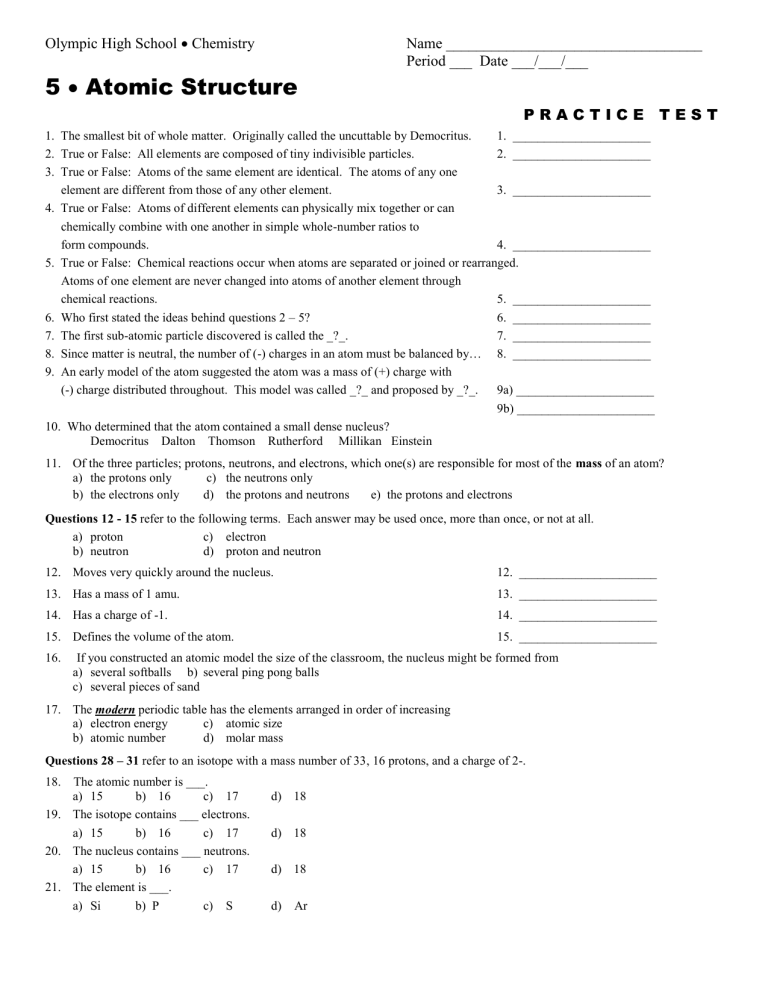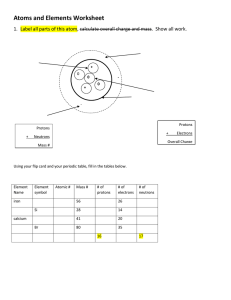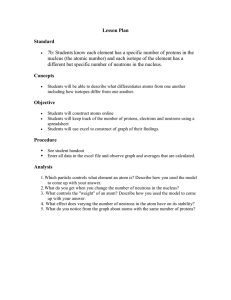5 Olympic High School Chemistry Name __________________________________

Olympic High School
Chemistry
5
Atomic Structure
Name __________________________________
Period ___ Date ___/___/___
P R A C T I C E T E S T
1. The smallest bit of whole matter. Originally called the uncuttable by Democritus. 1. ______________________
2. True or False: All elements are composed of tiny indivisible particles. 2. ______________________
3. True or False: Atoms of the same element are identical. The atoms of any one
element are different from those of any other element.
4. True or False: Atoms of different elements can physically mix together or can
3. ______________________
chemically combine with one another in simple whole-number ratios to
form compounds. 4. ______________________
5. True or False: Chemical reactions occur when atoms are separated or joined or rearranged.
Atoms of one element are never changed into atoms of another element through
chemical reactions.
6. Who first stated the ideas behind questions 2 – 5?
5. ______________________
6. ______________________
7. The first sub-atomic particle discovered is called the _?_. 7. ______________________
8. Since matter is neutral, the number of (-) charges in an atom must be balanced by… 8. ______________________
9. An early model of the atom suggested the atom was a mass of (+) charge with
(-) charge distributed throughout. This model was called _?_ and proposed by _?_. 9a) ______________________
9b) ______________________
10. Who determined that the atom contained a small dense nucleus?
Democritus Dalton Thomson Rutherford Millikan Einstein
11. Of the three particles; protons, neutrons, and electrons, which one(s) are responsible for most of the mass of an atom? a) the protons only c) the neutrons only b) the electrons only d) the protons and neutrons e) the protons and electrons
Questions 12 - 15 refer to the following terms. Each answer may be used once, more than once, or not at all. a) proton b) neutron c) electron d) proton and neutron
12. Moves very quickly around the nucleus. 12. ______________________
13. Has a mass of 1 amu.
14. Has a charge of -1.
15. Defines the volume of the atom.
13. ______________________
14. ______________________
15. ______________________
16. If you constructed an atomic model the size of the classroom, the nucleus might be formed from a) several softballs b) several ping pong balls c) several pieces of sand
17. The modern periodic table has the elements arranged in order of increasing a) electron energy c) atomic size b) atomic number d) molar mass
Questions 28 – 31 refer to an isotope with a mass number of 33, 16 protons, and a charge of 2-.
18. The atomic number is ___. a) 15 b) 16 c) 17
19. The isotope contains ___ electrons. a) 15 b) 16 c) 17
20. The nucleus contains ___ neutrons. a) 15 b) 16 c) 17
21. The element is ___. a) Si b) P c) S d) 18 d) 18 d) 18 d) Ar





